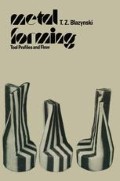Abstract
The study of the incidence, pattern and magnitude of the redundant deformation in any forming process requires that the processed specimen be suitably marked before the operation. The observed changes in the position, shape, and so on, of the marker, produced during the passage through the working zone, will be related to the redundant shears.
Preview
Unable to display preview. Download preview PDF.
References
Blazynski, T.Z. Optimisation of die design in the extrusion of rod using model materials. Int. J. mech. Sci. (1971), 13, 113.
Blazynski, T.Z., and Jubb, C. Dynamic and dimensional similarity of model and prototype Assel tube-elongating mills. J. Inst. Met. (1971), 99, 186.
Hill, R., and Tupper, S.J. A new theory of the plastic deformation in wire drawing. J. Iron Steel Inst. (1948), 159, 353.
Johnson, W. Experiments in plane strain extrusion. J. Mech. Phys. Solids (1956), 4, 269.
Frisch, J., and Thompsen, E.G. Trans. A.S.M.E. (1954), 76, 599.
Wistreich, J.G. Investigation of the mechanics of wire drawing. Proc. Inst. mech. Engrs (1955), 169, 654.
Blazynski, T.Z., and Cole, I.M. An investigation of the plug drawing process. Proc. Inst. mech. Engrs (1960), 174, 797.
Blazynski, T.Z., and Cole, I.M. An investigation of the sinking and mandrel drawing process. Proc. Inst. mech. Engrs (1963–4), 178, 867.
Johnson, W., and Kudo, H. The mechanics of metal extrusion. Manchester University Press (1962).
Loizou, N., and Sims, R.B. B.I.S.R.A. Report No. MW/A/50/52 (1953).
Karnes, C.H., and Ripperger, E.A. Strain-rate effects in cold-worked high-purity aluminium. J. Mech. Phys. Solids (1966), 14, 75.
Samanta, S.K. On relating the flow stress of aluminium and copper to strain, strain rate, and temperature. Int. J. mech. Sci. (1969), 11, 433.
Bodsworth, C., Halling, J., and Barton J.W. The use of paraffin wax as a model material to simulate the plastic deformation of metals. J. Iron Steel Inst. (1957), 185, 375.
Halling, J. and Mitchell, L.A. Advances in machine tool design and research (Proc. 5th Int. M.T.D.R. Conf.), Pergamon Press, Oxford (1965), 353.
Holmquist, J.L. Investigation of the piercing process by means of model wax billets. Iron Steel Engr. (1952), 29 (12), 53.
Blazynski, T.Z., and Cole, I.M. An analysis of redundant deformations in rotary piercing. Proc. Inst. mech. Engrs (1963–4), 178, 867.
Chang, K.T., and Brittain, T.M. An investigation of analog materials for the study of deformations in metal processing simulations. Proc. A.S.M.E., J. Eng. Ind. B (1968), 90, 381.
Cook, P.M. True stress—strain curves for steel etc. Proc. Conf. on Properties of Materials at High Rates of Strain. Inst. mech. Engrs (1957).
Hodierne, F.A. PhD thesis, University of London (1961).
Wilcox, R.J., and Whitton, P.W. The cold extrusion of metals using lubrication at slow speeds. J. Inst. Met. (1958–9), 87, 289.
Kocsis, I., and Zachar, L. Kohaszati Lapok (1957), (1–2), 71 (A.E.C. translation TR3836).
Feltham, P. in Metal Treatment (1956), 23, 440.
Orowan, E., and Pascoe, K.J. Iron Steel Inst. Special Report No. 34 (1946), 124.
Blazynski, T.Z. Strain rates in wire drawing and tube-making. Engineer (1967), 223, 627.
Oxley, P.L.B. Allowing for strain effects in the analysis of metal working processes. In Mechanical properties at high rates of strain, Institute of Physics (1975), 359.
Bramley, A.N., and Mellor, P.B. Some strain rate and anisotropy effects in the stretch-forming of steel sheets. Int. J. M. T.D.R. (1965), 1, 37.
Vaidyanathan, P.V. PhD thesis, University of Leeds (1972).
Shabaik, A., Lee, C.H., and Kobayashi, S. Application of the visioplasticity method to extrusion through a conical die. Proc. 7th Int. M.T.D.R. Conf, Pergamon Press, Oxford (1966), 633.
Shabaik, A., and Kobayashi, S. Computer applications to visioplasticity method. Trans. A.S.M.E., J. Eng. Ind. B (1967), 89, 339.
Shabaik, A., and Thompsen, E.G. A theoretical method for the analysis of metalworking problems. Trans. A.S.M.E., J. Eng. Ind. (1968), 90, 343.
Medrano, R.E., and Gillis, P.P. Visioplasticity techniques in axisymmetric extrusion. J. Strain Analysis (1972), 7, 170.
Author information
Authors and Affiliations
Copyright information
© 1976 T. Z. Blazynski
About this chapter
Cite this chapter
Blazynski, T.Z. (1976). Experimental Determination of Redundant Deformation. In: Metal Forming. Palgrave, London. https://doi.org/10.1007/978-1-349-02861-0_3
Download citation
DOI: https://doi.org/10.1007/978-1-349-02861-0_3
Publisher Name: Palgrave, London
Print ISBN: 978-1-349-02863-4
Online ISBN: 978-1-349-02861-0
eBook Packages: EngineeringEngineering (R0)

